Workplace Personal Protective Equipment (PPE) - Your Ultimate Guide
Personal Protective Equipment generally goes by the acronym: PPE. It is the equipment that protects its users from health or safety risks. Most specifically, risks you would find in the workplace.
The Ultimate Guide to PPE includes an explanation of all relevant PPE regulations, best practice advice for health and safety officers or those charged with ensuring compliance, and useful resources for extra reading. You will also find examples of each type of PPE with links to more in-depth information.
You can jump to each section using the following links:
- Page Contents
- What is Personal Protective Equipment?
- The Importance of PPE versus other safety measures
- The importance of PPE for protecting against injury
- Workplace PPE Legislation and Regulation
- Regulations for PPE Quality
- Health & Safety Duties of Employers
- Health & Safety Duties of Employees
- Can Employers Charge for PPE?
- Assessing Suitability
- Types of PPE and their importance
- Why XAMAX® Should Be Your PPE Supplier of Choice
- Get In Touch
- Conclusion
Before we start, let's be absolutely clear. This is a workplace safety guide relevant to the UK. When we discuss PPE, we are talking industrial grade personal safety equipment designed to protect workers from the hazards of the workplace - we're certainly not talking about the low quality rubbish you can buy from your newsagent.
What is Personal Protective Equipment?
Workplace PPE is any equipment designed to protect the wearer from any hazard that can not be ruled out through other Health & Safety practices.
That phrase "other Health & Safety practices" is the real key to a safe working environment. PPE is the last line of defence an operative has against the risk of injury or illness from their work. It is no substitute for safe working practice by a well trained employee in a risk managed work environment.
But some element of risk is inevitable in many workplaces, that is where Personal Protective Equipment (PPE) comes in.
As well as providing a safe working space and effective training, employers have a legal duty to provide PPE to employees and ensure its correct and safe usage while at work.
So it would help if you knew what it does and does not consist of...
PPE does include:
- Hard Hats & Safety helmets
- Gloves
- Eye protection
- Hazmat suits
- *Hi Vis clothing
- Safety footwear
- Safety harnesses
- Ear plugs and ear defenders
- Respiratory protective equipment
PPE does not include:
- Work clothing or Uniform not specifically designed to protect the Health & Safety of the wearer
- Food hygiene clothing
- Healthcare hygiene clothing (eg: plastic aprons or surgical masks)
- Protective equipment designed for use on a public road (bike helmets, motorcycle gloves etc)
- Sports protective equipment for use within the sport (although, a life jacket worn by sailing instructor would be PPE)
- Weapons used for defence (but body armour worn by the Police or Military would be classed PPE)
- Portable devices used for detecting risk (eg: Carbon Monoxide Detectors, Giger counters etc)
- The cloth/paper face coverings at your local petrol station - as they aren't designed to protect the wearer.
*There's a Caveat for Hi Vis as Personally Protective Equipment. Read More Here
The Importance of personal protective equipment related to other measures
Believe it or not, PPE actually ranks at the very bottom of the workplace risk management pecking order. It is considered a "last line of defence". That does not mean it is not important - everything in risk management is as important as the next item - it just means everything above it must be dealt with before you even consider its use.

Where a hazard cannot be completely controlled and removed to avoid risk of harm altogether, PPE is appropriate for use and would be covered by the PPE regulations.
The reasons for this approach include:
- Only the person wearing the PPE is protected - but if risk is controlled at source, everybody in the vicinity is somewhat protected.
- As PPE can only be effective when it is properly used - that is fitted correctly, well maintained and worn when required - so it is impossible to assess the true level of protection it gives.
- Workers may be restricted or limited by using PPE - for instance a pair of Goggles may impair vision slightly, a large leather apron may impair mobility, or an air-fed respirator would increase the weight carried, and therefore fatigue, of the wearer.
- Using PPE may give the wearer a false sense of security - the attitude towards, and perception of hazard associated with the job must remain meticulous. Complacency is a major cause of accidents.
- As a last resort of protection, PPE is of critical importance as it is used only when other measures are unable to protect the user from occupational hazards.
The importance of PPE in protecting from injury
The numbers speak for themselves: people get hurt at work and it is preventable. Nobody leaves for work on a morning thinking their life is about to change for the worse, but that is what can happen. Even small injuries affect a workers quality of life, affect mobility or increase stress. That should be avoided by everyone responsible for worker safety.
This infographic provides some key facts and figures:

Workplace Legislation Covering PPE
The use of and necessity for PPE in the UK is required by various acts of Parliament. Contrary to populist belief, UK workers are better protected by UK H&S law than any EU law. We will get to a specific EU law you may have heard about, but we shall start with UK and Great British Law
Here we will outline some of the main points of legislation employers and employees need to understand.
The Health & Safety at Work etc. Act 1974
The Health and Safety at Work, etc Act 1974 Section 2 (1) says:
It shall be the duty of every employer to ensure, so far as is reasonably practicable, the health, safety and welfare at work of all his employees.
This places a general duty of care on employers to ensure the safety of employees. Those not in their employ are also covered by Section 3 (1):
It shall be the duty of every employer to conduct his undertaking in such a way as to ensure, so far as is reasonably practicable, that persons not in his employment who may be affected thereby are not thereby exposed to risks to their health or safety.
This act requires that employers make no charge for anything done in order to comply. Section 9 of the H&S at Work act says:
No employer shall levy or permit to be levied on any employee of his any charge in respect of anything done or provided in pursuance of any specific requirement of the relevant statutory provisions.
As such, employees must not be charged, either in advance or by a dock in wages, for their use of PPE or any other item required to keep the employee or those in the workplace safe from hazards.
The Management of Health and Safety at Work Regulations 1999
This UK Legislative Regulation requires both employers and self-employed people to carry out "suitable and sufficient risk assessment" for all work activities for the purposes of understanding and deciding what measures are necessary for safety.
Section 3 (1)(a)&(b) covers employers, and says:
- (1) Every employer shall make a suitable and sufficient assessment of —
- (a) the risks to the health and safety of his employees to which they are exposed whilst they are at work; and
- (b) the risks to the health and safety of persons not in his employment arising out of or in connection with the conduct by him of his undertaking
for the purpose of identifying the measures he needs to take to comply with the requirements and prohibitions imposed upon him by or under the relevant statutory provisions and by Part II of the Fire Precautions (Workplace) Regulations 1997.
Section 3 (2)(a)&(b) covers self-employed workers, and says:
- (2) Every self-employed person shall make a suitable and sufficient assessment of —
- (a) the risks to his own health and safety to which he is exposed whilst he is at work; and
- (b) the risks to the health and safety of persons not in his employment arising out of or in connection with the conduct by him of his undertaking
for the purpose of identifying the measures he needs to take to comply with the requirements and prohibitions imposed upon him by or under the relevant statutory provisions.
Any person made responsible for carrying out a risk assessment needs to identify any potential risk or hazard arising from the work activity and establish precautions and safety measures available to protect people from harm.
Providing PPE is legitimate where there is a presence of hazards causing risk to workers or others BUT it should only be applied once other measures have been taken to remove, reduce or isolate the hazard, yet a hazard remains.
Personal Protective Equipment at Work Regulations 1992
Regulation 4 of this legislation makes it absolutely clear that employers must provide suitable PPE for employees exposed to health and safety risks except "where and to the extent that such risk has been adequately controlled by other means which are equally or more effective". A similar duty applies to self-employed workers with regard to supplying PPE for their own use and is covered within the same regulation:
- (1) Every employer shall ensure that suitable personal protective equipment is provided to his employees who may be exposed to a risk to their health or safety while at work except where and to the extent that such risk has been adequately controlled by other means which are equally or more effective.
- (2) Every self-employed person shall ensure that he is provided with suitable personal protective equipment where he may be exposed to a risk to his health or safety while at work except where and to the extent that such risk has been adequately controlled by other means which are equally or more effective.
- (3) Without prejudice to the generality of paragraphs (1) and (2), personal protective equipment shall not be suitable unless—
- (a) it is appropriate for the risk or risks involved and the conditions at the place where exposure to the risk may occur;
- (b) it takes account of ergonomic requirements and the state of health of the person or persons who may wear it;
- (d) so far as is practicable, it is effective to prevent or adequately control the risk or risks involved without increasing overall risk;
- (e) it complies with any enactment (whether in an Act or instrument) which implements in Great Britain any provision on design or manufacture with respect to health or safety in any relevant Community directive listed in Schedule 1 which is applicable to that item of personal protective equipment.
PPE regulations affecting importers, distributors and retailers
Now, over to Brussels...
You may have heard of a fairly recent EU regulation on PPE that came into effect in 2018: it has a very long winded name:
REGULATION (EU) 2016/425 OF THE EUROPEAN PARLIAMENT AND OF THE COUNCIL of 9 March 2016 on personal protective equipment and repealing Council Directive 89/686/EEC
This regulation does not concern the use of PPE at all. In fact, its only purpose is to standardise the quality of PPE on the market to protect consumers and ultimately workers from non-compliant safety equipment.
The regulation only affects importers, distributors and retailers. This group now shares the responsibility of providing safe and effective PPE products with the manufacturers. Everyone in the PPE industry is legally required to comply.
This EU health and safety legislation on PPE replaced the 25-year-old Council Directive in order to better reflect how PPE is manufactured and brought to market in the 21st Century. This was approved and became official on 31st March 2016 - becoming Law on 21st April 2016 - leading to all EU member states adopting the legislation.
Full enforcement began on 21st April 2018 as the old PPE Directive was repealed and all Personal Protective Equipment must now be certified to the new Regs.
You will notice it is now a "Regulation" and not a "Directive" - this significant change makes it a binding legislative act rather than just a target for EU countries to achieve.
By becoming an international law, all Europeans are getting safer and more appropriate PPE.
And post-Brexit, the UK is keeping that legislation.
Key Changes in Responsibility
All companies that trade in PPE - be those producers, importers, suppliers, distributors, marketers or sellers - now have the same responsibilities as the original manufacturers. This includes ensuring it conforms to regulation and keeping records of all technical files.
This regulation had the desired effect, and now much fewer fake and under-specification PPE product has reached the EU marketplace, and the UK in particular.
Other Changes
- Product categorisations are now related to risk
- Certain product categories now have a different classification; eg: Hearing Protection, now 'harmful noise' has been moved from category II to III
- An "EC Declaration of Conformity" must now be provided with each product sold - a URL or web link to documentation is sufficient.
- All EU Certificates now have a 5-year validity and/or expiry date
- An Increase in obligations of "economic operators", meaning the entire supply chain: manufacturers, importers and distributors etc (see above)
PPE will not satisfy the suitable requirement unless:
- It is appropriate for the risks and the conditions at the place of work
- It takes the ergonomic requirements and the state of health of the person who may wear it into consideration
- It fits the wearer correctly if worn as designed
- It prevents or adequately controls the risk, without increasing overall risk - So Far As Is Reasonably Practicable
- It complies with community directives (i.e. CE marked)
The Regulations also require that:
- If multiple items of PPE need to be worn, then all items need to be compatible with each other and the law.
- PPE items must be properly assessed before they are used to:
- ensure suitability for its purpose
- to assess all risks the PPE is required to control
- PPE is maintained in good working order and in good repair.
- Appropriate storage is provided for when the PPE is not in use.
- Employees are provided with training on the risks the PPE will prevent or limit, the reasons for using the PPE, the correct way to use it effectively, the actions required to keep it in good order.
- Employers must take steps to ensure the PPE is used correctly by their employees.
- Employees also have a duty to use PPE in accordance with their training, report loss or defect and to store the PPE as instructed.
- Self-employed also now have a duty to make full and proper use of PPE.
The Regulations do not apply where there is over-riding legislation for the provision and use of PPE in relation to specific hazards. Such as:
- The Control of Lead at Work Regulations 2002.
- The Control of Asbestos Regulations 2012.
- The Control of Substances Hazardous to Health Regulations 2002 (as amended)
- The Control of Noise at Work Regulations 2005 (as amended).
- The Ionising Radiations Regulations 1999.
The Health & Safety Duties of Employers
Personal Protective Equipment is the last line of defence, so employers need to work to reduce workplace hazard and risk by other means first. PPE should be provided to employees where a health and safety risks cannot be adequately controlled by other means.
Where risks cannot be generally controlled, PPE must be provided and must:
- Be appropriate for the risks and for the working Environment.
- Be appropriate with regard to the user’s health, size & shape and be compatible with any other PPE that needs to be worn.
- Give sufficient control over the risks created by the hazard, without inflating other risks surrounding the worker.
- Made available free of charge when supplied within the work environment for work related Health & Safety.
- Be maintained and stored correctly.
- Satisfy the relevant laws and legislation regarding the manufacture, import/export and supply.
It is also recommended that employers:
- Consult the wearers of PPE before items are supplied, as workers know best what is needed for their tasks and their working environment.
- Maintain records of PPE items issued, including:
- Who received it
- Who supplied it
- The date of issue
- The date of replacement or maintenance
All humans are equal, but we are different. There are differences in physicalities of every worker, so there is no "one-size-fits-all" when it comes to PPE. Gender, Ethnicity, Lifestyle and even Age can all have an affect on the shape and size of PPE that's needed to protect the wearer - it stands to reason that different sizes and types of PPE must be made available for the workforce.
PPE should be adjustable and appropriate and you should seek advice should there be any medical condition that could affect the usage.
For respiratory protection that is designed to seal against the face, each employee will need a proper face fit test to ensure the correct shape for their face.
Training and information will also need to be provided. In providing this the following details should be included of:
- The risks the PPE is designed to prevent, avoid or limit
- The correct way in which to use the PPE
- Checks to be performed by the wearer to ensure correct usage
- Maintenance procedures to ensure maximum protection from the PPE
- Action to be taken by the employee should the PPE not be suitable for use
When an employer provides an employee with PPE training, they should ensure it is fully comprehensible, taking into account literacy and language. It should cover the practive of using their PPE as well as the theory behind it so that all users have a full understanding of when, why and how to use their PPE.
Employers need to demonstrate the correct use of PPE, or at least organise demonstrations, with regular training to refresh workers. This part of the legislation is dependant on the PPE being used. There isn't much training you can give for a hi vis vest, but for a harness for working at height more training would be required.
Although it's illegal for suppliers to sell PPE that doesn't conform and carry the relevant CE mark, it is still up to employers to make sure that the PPE supplied conforms. So simply give every delivery the quick once over to make sure.
Any PPE used must be in full working order, properly maintained and used within manufacturer's guidelines and instructions. It is the responsibility of the employer to ensure this happens, so a system of maintenance and monitoring should be made policy within your business. The end goal of this policy is to ensure periodic checks and records of testing and replacement.
There should always be a stock of proper CE marked spares incase PPE is damaged or detective. Any repairs made should be done by someone competent to do that work. Any items awaiting repair should be clearly marked as defective and stored away from usable PPE.
As part of the policy of checks and maintenance, you should include a system for employees to report and missing, lost or defective PPE so you can have them replaced quickly.
There should also be a system by which employees can report missing or lost items of PPE and arrange for them to be replaced.
The Heath & Safety Duties of Employees
Employees are required by law to use and personal protective equipment as directed. It must be used exactly in accordance with the information, training or instructions they have been given.
They must store PPE properly in a defined storage area unless agreed with their employer. They must look after and maintain it correctly and immediately report any defects, damage or loss to their employer.
Can employers charge employees for PPE?
Employees must not be charged for their PPE, either initially or when replaced. It doesn't matter if it can be returned and reused or is a one-off use item. It must be provided free of charge by the employer. This includes agency workers if they are legally considered to be employees.
When an employee leaves their job for whatever reason, they should return any and all PPE back to their employer. If they fail to do so, the employer is allowed to deduct the cost from their final wages - but only if that is specified in the employment contract.
Assessing what PPE is suitable
Not all PPE is created equally. Different hazards require different types and levels of protection, so it is vital the correct PPE is chosen based on the unique hazards found in your workplace.
To make an adequate assessment of the suitability of PPE, you should ask yourself the following questions:
Is this piece of PPE appropriate for the unique hazards and the conditions of the workplace where the worker could be at risk?
For instance; protective eyewear designed to protect against sparks and debris from cutting or grinding steel would not be be appropriate for use in a chemical lab.
Is this item of PPE adequate to effectively reduce, completely prevent or control the specific risk in my workplace without increasing risk to other hazards?
For instance; a pair of safety boots may be needed to protect toes from falling objects, but if the wearer is working on a slippery surface, those boots would need anti-slip ratings to reduce the risk of falling objects without increasing the risk of slips and falls.
Does this PPE fit the wearer correctly?
For instance; respiratory protection will need "fit testing" to ensure a good seal to the wearers face. If it doesn't fit properly, it doesn't provide any protection.
Have any specific needs of the wearer been considered?
For instance; If a worker has ongoing ear issues, such as an infection or Temporomandibular disorder (TMD), it would be detrimental to their health and recovery for them to wear ear plugs. As such, ear defenders would be more appropriate.
If the hazards require two or more items of PPE, are they compatible with each other?
For instance; the worker will be cutting and grinding galvanised steel and would need eye protection, hearing protection and respiratory protection. A respirator may prevent safety goggles from fitting correctly, and safety spectacles may prevent ear defenders from fitting correctly. As such, a full face shield and ear plugs, or a full face shield with attached ear defenders would be more appropriate.
What are the requirements of the job and it's demands on the worker?
If in doubt, always ask a BSIF registered Safety Supplier like XAMAX®, we'll keep you on the right path.
What are the Different Types of PPE and why are they important?
The workplace has various hazards and each hazard type has it's own category of PPE. The HSE provides general guidance and information on the types of industrial PPE, but it doesn't cover specialised safety items.
You should always get detailed information for your PPE supplier for any specialised item, and the users should be involved in the selection of the equipment they will wear. If possible, multiple models of each item should be made available to ensure a correct fit.
We've already covered the fact that any PPE used must be appropriate for the risks and hazards, but what are the different types of PPE?
The types of protection set by the Health and Safety Executive (HSE) in the UK are:
- Click to jump to section
- Eye & Face Protection
- Hand & Arm Protection
- Head & Neck Protection
- Respiratory Protection
- Hearing Protection
- Safety Footwear
- Body Protection
Whilst choosing the equipment you need is important that workers wear PPE designed for their specific workplace hazards. If they don't, life changing injuries can occur. A properly completed risk assessment will identify the types of hazards and risks in your workplace. A properly designed safety policy will ensure everyone stays safe.
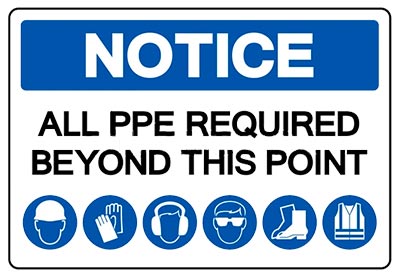
Why is Eye and Face protection important?
Eye and Face PPE is intended to provide protection for eyes against impact, cuts, splashes, mists and sprays. The standards you need to look out for are BS 7028 (Guide to Selection of Eye Protection for Industrial and Other Uses) and BS EN 166 (Specification for Eye Protectors).
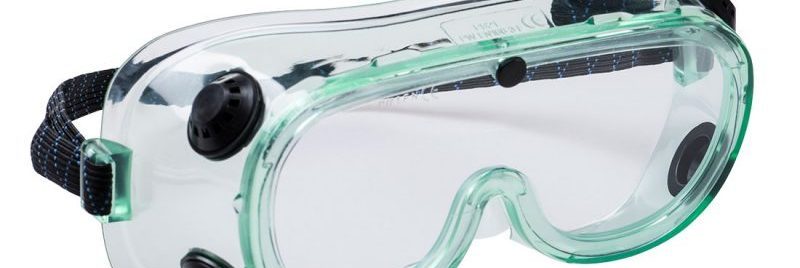
All eye protection should be kept in good order and be cleaned regularly, as dirty safety lenses lead to poor vision which may be a contributing factor in workplace accidents.
Should lenses be scratched, pitted or cracked they need to be replaced immediately.
If workers normally wear corrective lenses, any eye or face PPE should accommodate them. E.G. Safety goggles should be large enough to fit over the top of normal eye wear, or safety spectacles should be fitted with protective prescription lenses designed for that specific wearer.
According to Manchester Royal Eye Hospital and Manchester University, in 2019:
- 90% of all eye injuries were preventable.
- 60% of injured workers were not wearing any PPE.
- 40% of injured workers were not wearing the correct type of eye protection.
Protective eye equipment is one of the most important and widely used pieces of PPE. As the old adage goes: you only get 1 pair of eyes
See a range of Eye and Face Protection products here
Why is Hand and Arm protection important?
Almost all work tasks need a certain level of dexterity. There aren't many jobs that don't just the hands and in industry, that exposes our most valuable tools to a range of hazards and risks.
Cuts, abrasion, laceration, chemicals, vibrations, infection, heat, cold, burns, irritation, dermatitis, de-gloving - not a dance card anyone want's to fulfil.
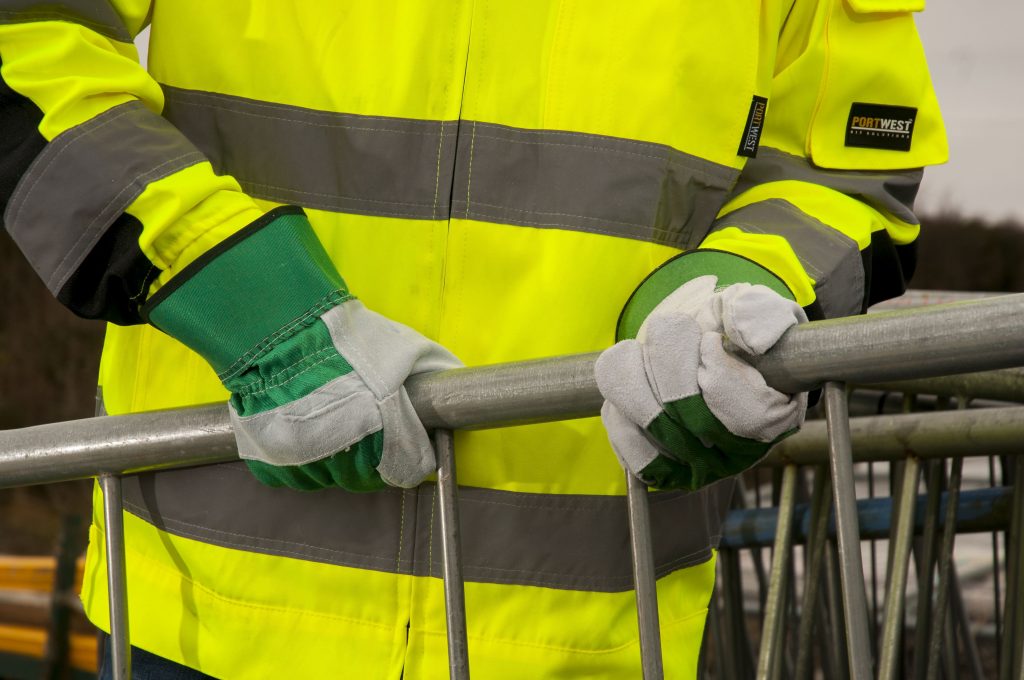
After the hierarchy of control measures has been followed, gloves, gauntlets, mitts, cuffs and sleeves provide hand and arm protection against a multitude of hazards.
Normal manual handling would be the lowest form of risk, where abrasive or sharp objects create a hazard. Not to mention the constant action of objects against the skin causing blisters. For these kinds of light hazards, you should offer workers a standard manual handling glove, such as a rigger glove, or perhaps a grip glove to aid their work.
Some hazards far exceed those a warehouse operative may encounter. For instance:
A pneumatic hammer operator would risk vibration white finger from the constant vibrations. Anti-vibration gloves would be suitable hand protection in this case.
A line butcher would be at constant risk of a severe injury from a sharpened blade. high level cut-resistant gloves and a cut sleeve would be suitable.
A cold store worker would be at risk of frostbite. Thermal handling gloves would be necessary for the worker's safety.
This is clearly a non-exhaustive list and the type of hand and/or arm protection you or your staff need is specific to the work you do.
Remember though: Gloves should not normally be worn if there is a risk of them being caught in machinery.
See a range of Hand & Arm protection products here
Standards to look out for:
- The safety standard specifications for protection against mechanical hazards is BS EN 388
- The safety standard you should adhere to for gloves and sleeves to protect against cuts is BS EN 14328.
- The safety standard for gloves that protect against heat and/or fire is BS EN 407.
- The safety standard for protection against cold hazards is BS EN 511.
- The safety standard for hand protection against chemicals and micro-organisms is BS EN 374 Part 1
There has been a steady increase in workers contracting contact dermatitis according to the HSE. Carpal tunnel syndrome, Vibration white finger and digit amputation are also serious risks in many trades.
The right kind of safety gloves or sleeves protect your hands and arms from all sorts of injuries, from the slightly annoying to devastating and life changing: abrasions, extreme temperatures, cuts, punctures, electric shocks, chemicals, vibrations and more.
Why is Hearing protection important?
Hearing loss is a serious detriment to quality of life, as is Tinnitus, and in most cases it is absolutely avoidable. Do you want to retire deaf? No, of course not, and neither does anyone else.

You should know if workers need personal ear protectors or not after carrying out a risk assessment under the Control of Noise Regulations 2005. This will also tell you the noise attenuation (dampening) you'll require.
You're looking for BS EN 352 Part 1 as the relevant hearing protection standard. You can learn more about how to choose the correct hearing protection in our guide here.
You should select protectors that are suitable for the working environment and consider the wearer's comfort and especially the hygiene requirements. Remember ear plugs go inside the ear, so need fitting with clean hands. If this is not possible, then ear defenders would be more suitable, but only if they can be used with other PPE.
There is no hierarchy of importance for PPE - all PPE is important (the hierarchy is for control measures). The temptation to go without hearing protection because hands are dirty and ear defenders won't fit under hard hats is not acceptable, solutions must be found, and indeed, exist. It is the employer's responsibility to provide correct and useable PPE and enforce its use.
Employers should provide a range of hearing protector types to allow employees a choice depending on the work they do or even a personal preference.
See a range of Hearing protection products here
The exact required noise attenuation calculated during the risk assessment is hardly ever possible to achieve, so it is important that hearing protection is over specified in these cases. there is no "Close enough".
For all hearing protector types, there will be a need for at least some training for the workforce. Ear plugs seem simple to use but can be used incorrectly, which is akin to not using them at all. Ear defenders require maintenance and appropriate care in use. It may even be that your work environment requires both ear plugs and defenders to be used together.
Why is Head and Neck protection important?
A Labour Force Survey (LFS) discovered that 13% of the 5,055 non-fatal construction injuries reported in 2016 and 2017 were due to being struck by falling objects.
In 2018/2019, HSE had 71,062 non-fatal injuries reported, 10% of which were due to being struck by a moving object.
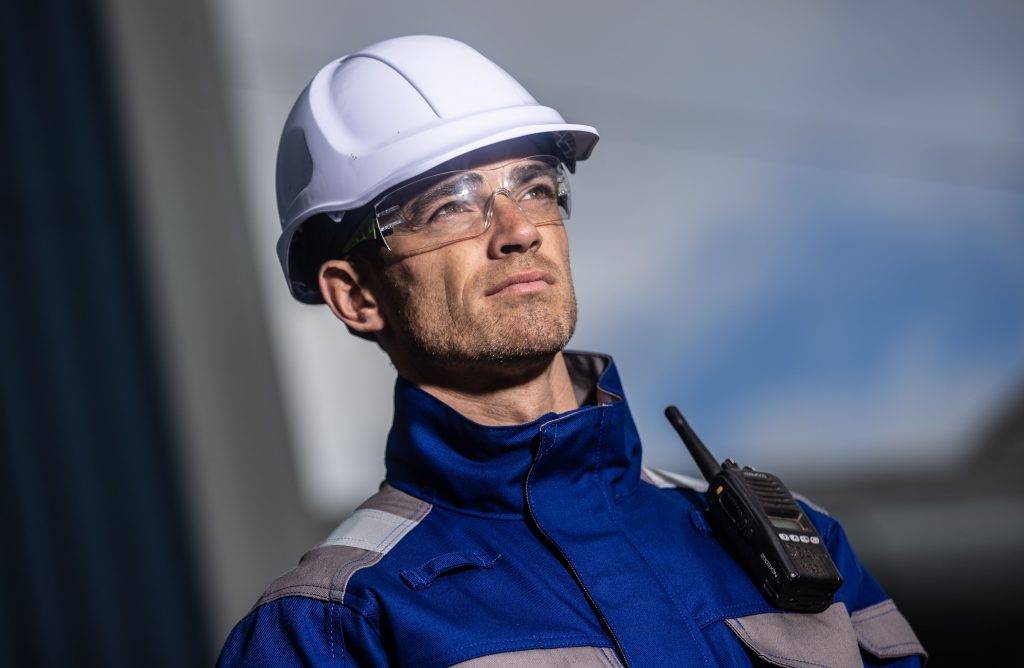
There are five primary purposes of head protection, to protect against specific hazards. Head protection should protect:
- The head in falls;
- Against falling objects, impact with fixed objects, or wielded weapons;
- The head by offering thermal insulation;
- Against entanglement and laceration to the head;
- Against scalping/entanglement particularly on machinery where injuries are still numerous.
See a range of Head protection products here
All forms of PPE for head and scalp protection must fit correctly, have adjustable headbands, nape and chin strap (if appropriate) and be suitable to protect against intended hazards. The relevant standards for head protection you should look out for are BS EN 397 and BS EN 14052.
Hard hats (or Safety Helmets) are designed to protect the wearer from falling or flying objects and from hair getting caught in machinery. They are an integral part of worker protection and the correct type of hard hat must be used. But you must also choose the correct colour hard hat for construction sites.
When the hazrd is overhead but not moving, a Bump cap would be more appropriate PPE. These protect the wearer from "bumps", so are perfect for working under vehicles.
Remember that Hard Hats and Bump Caps do not offer he same levels of protection, have different uses and are not really interchangeable.
Why is Respiratory protection important?
This type of PPE has been in the news a lot recently, you might have noticed.
But all that news has created misconceptions as to what really constitutes respiratory PPE and what really doesn't. We remind you that we're talking industrial and workplace PPE in this guide, so the face cloths and paper towels at 4 for a quid are not going to be mentioned again.
We also won't be talking about the KN95 type masks. There's an article here about why you SHOULD NOT be using those in a workplace setting. Ever.
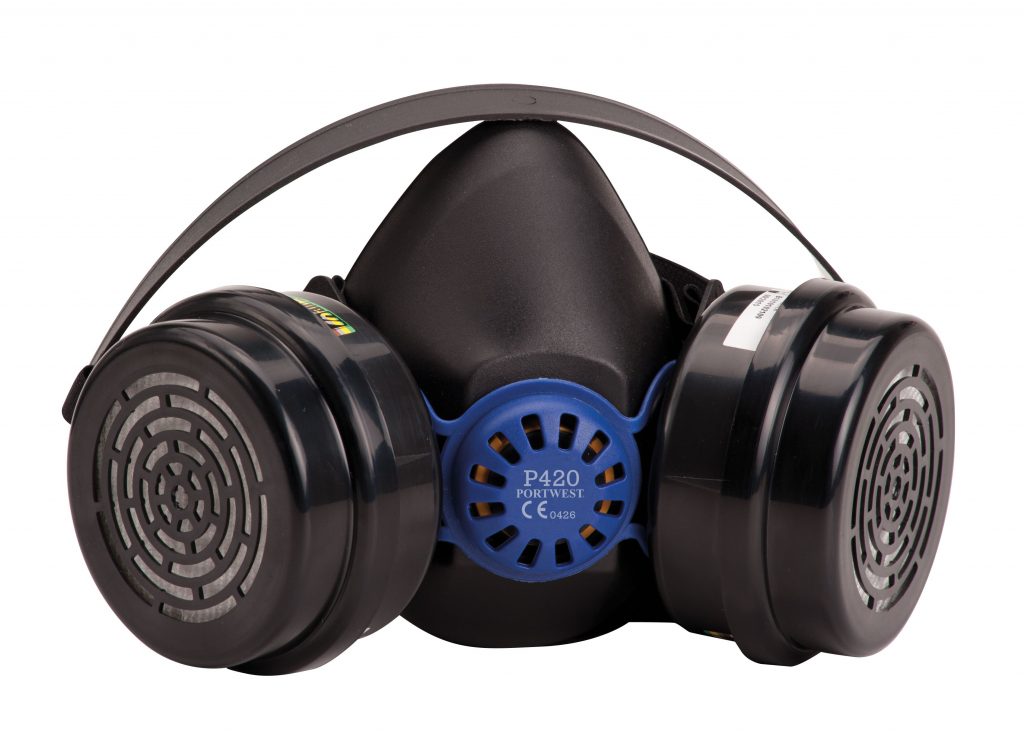
What we will talk about are the FFP1, FFP2 and FFP3 dust masks. We have an in depth and internationally renowned (yes really) article about workplace respiratory protection here, but for a quick overview, read on.
Workplace environments have a great deal of risk and none more prevalent than the particulates in the air you breath. That can range from simple wood dusts caused by sanding to oils, vapours and gases created from more advanced working practices. Some particles and droplets cause almost instant breathing difficulties. Some, such as asbestos, can cause terminal diseases way in the future.
To protect workers from these hazards, employers must provide suitable respiratory protection, designed for the specific risks employees face. FFP1 is the lowest form of protection, so probably wood dusts from sanding and cutting. Not very nice to inhale, but it probably won't kill you.
FFP2 is for finer dusts, perhaps powders such as cement dust, but they also protect against fine oil based vapours and fumes, so would be the minimum recommendation for welders, fabricators etc.
FFP3 is the highest rating available in face mask form. The UK has the highest rating in the world which far exceeds the highest rating the US has (N95). It is used for all dusts, particles, vapours and gases, and utilises electro-static charges to adhere these nasties to the filter fibres.
You'll find FFP2 and FFP3 in disposable and half mask cartridge form. The benefits of half masks are a better fit and long-term cost-efficiency. Before you ask, XAMAX® only sell these masks to businesses that use them for their work - and we WILL ask and check - they are not for resale and certainly not to the public. We have to protect stocks, even now, so we set this policy long ago.
Any worker requiring respiratory protection should undergo a face fit test to ensure the right mask for the face shape. Some compromises may need to be made by the wearer, such as shaving properly to ensure a tight seal, or a different type of hearing protection be worn. However no compromise should be made on the mask itself other than its adjustable elements. If it doesn't fit, get a different size and/or brand.
Another survey of 80,000 construction workers by LFS showed that 3,000 were suffering from respiratory illnesses that were caused by their work.
It was reported by HSE that around 12,000 people a year die from lung diseases attributed to their work lives, with a total of 20,000 cases when including self-reporting.
And so it is essential that workers doing jobs that have any respiratory risk involved are provided with, and wear, the correct respiratory protective equipment (RPE).
See a range of Respiratory protection products here
Remember, the wrong kind of respiratory protection is no protection at all.
Why is Foot and Leg protection important?
In 2016-2017 there were 5,055 non-fatal injuries reported within the construction injury and HSE found the majority of those were caused by slips, trips or falls. Due to there being a variety of debris and waste littering almost every construction site, this makes trip or slip hazards especially common.
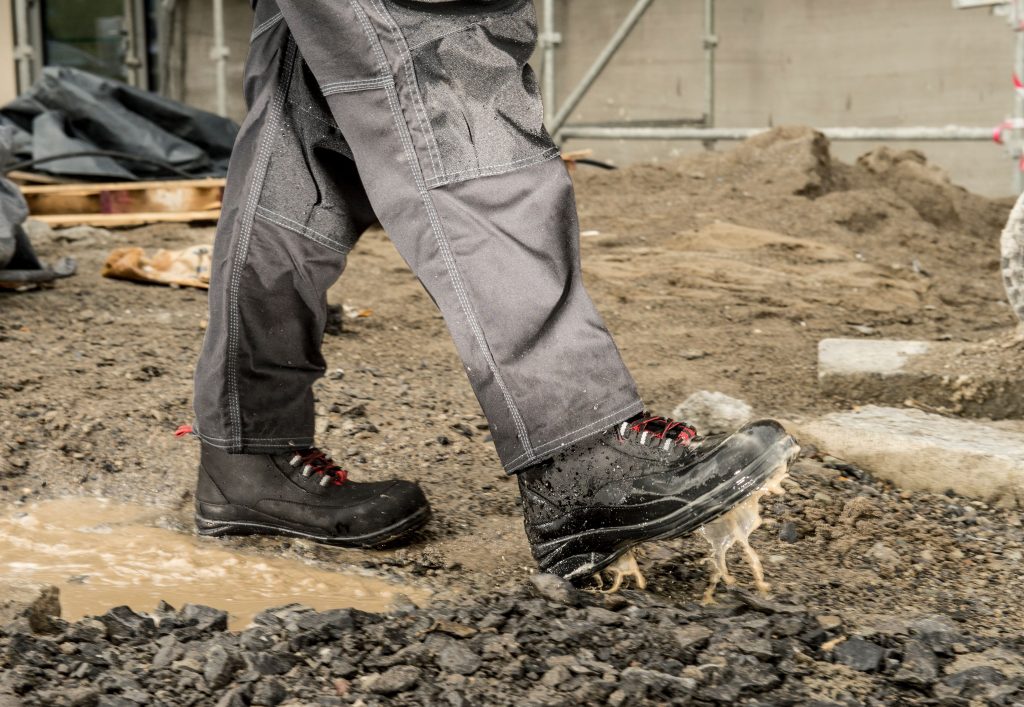
Other injuries were caused by heavy items crushing the feet or legs an from sharp items causing piercing injury. All this could have been avoided if employees were wearing appropriate foot protection to ensuring feet and legs are suitably protected from hazards.
When most people think about foot and leg protection, they think about toecaps, but hazards go beyond the need to just protect the toes.
XAMAX® have created a guide to safety footwear standards, and a guide on choosing the correct safety footwear protection for your role.
Workplace risks against the foot could include slips, piercing, crushes, high or low temperature, electricity, cuts, chopping and even chemicals. Depending on the hazards identified in your risk assessments, you would need safety footwear to offer a multitude of protections - and not just for the feet.
Uneven work surfaces present a hazard of ankle rolling, that could sprain or break the worker's ankle or leg. Weather conditions also present their own individual hazards.
The safety footwear standards relevant to you would likely be BS EN ISO 20345, which specifies an array of different standards to protect against various different hazards.
If the worker is to use a chainsaw, the standard to look out for is BS EN ISO 17249:2004, which offers chainsaw specific protection.
See a range of Foot protection products here
It is always best to understand the risks workers face in their roles before choosing safety boots, trainers or shoes. There is no one-size-fits-all safety footwear. Different employees may need different types of footwear to ensure their safety, and it is the employers responsibility to provide that footwear.
Knee Protection
Kneepads protect the knees when kneeling and can very much improve the wearers comfort and safety. They come in various forms that either slot into workwear trousers or tie around the mid-leg. You're looking for EN 14404:2004+A1:2010 as the standard for these.
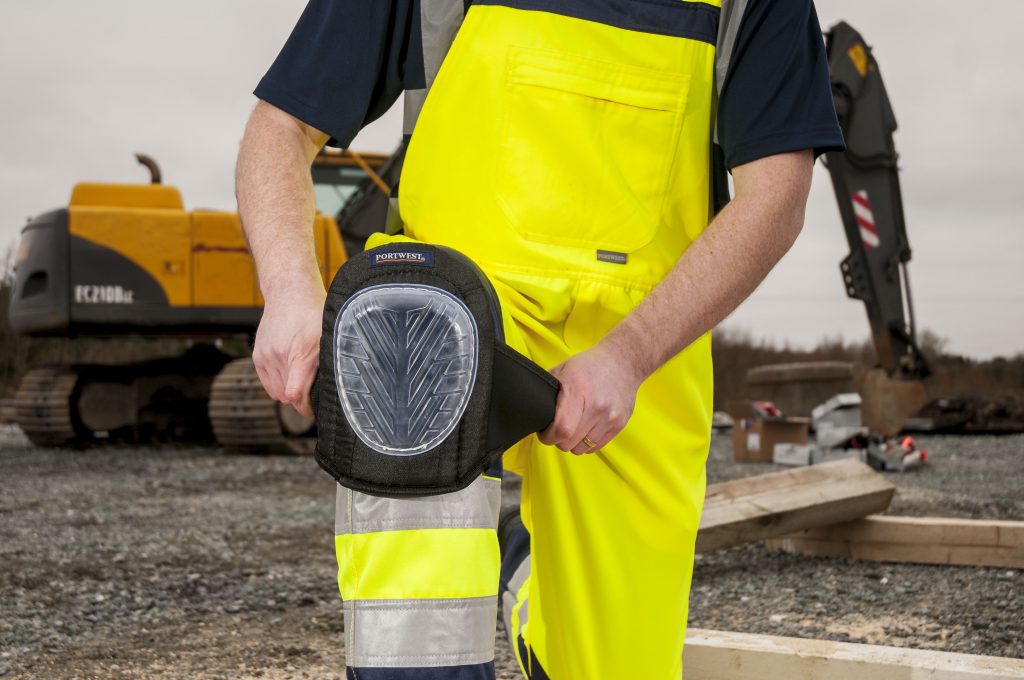
See a range of Knee protection products here
Not all knee protection comes in the wearable form. Some jobs may be better suited to a kneeling mat, especially if wearable kneepads aren't required constantly. As usual, the type of rotection you choose is absolutely dependant on the tasks at hand.
A quick note on Hi Vis Clothing
You may be surprised to find no real mention of Hi Vis in this PPE guide. There is a very good reason for that: Hi Vis is not really PPE. It might protect the wearer from the elements if it's waterproofed, but that is not the purpose of Hi Vis.
Hi Vis is special and needs an ultimate guide all of its own. If you're looking for more on Hi Vis clothing, XAMAX® has a handy guide to everything you need to know about Hi Vis Clothing here.
Why is Body protection important?
Health and Safety regulations exclude common or garden work uniform and workwear that don't offer any specific protection to wearers. But, when working outdoors and especially near vehicular traffic, hi vis clothing is very likely to be needed. That would be the EN ISO 20471 regulations, which we cover in detail here.
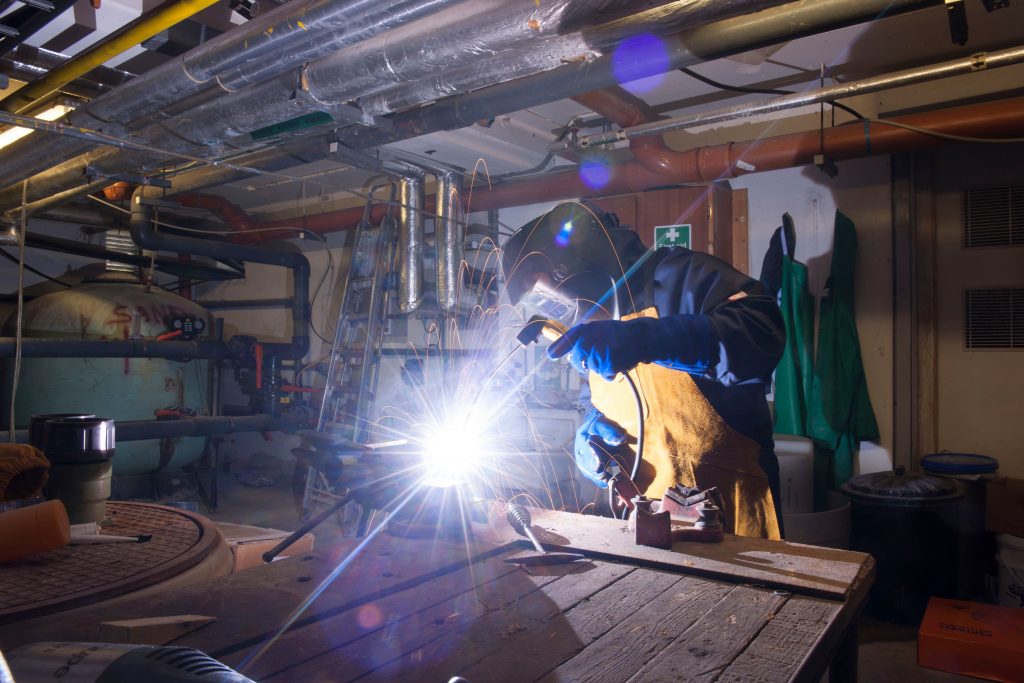
For some working environments, body protection is needed to protect against hazards such as chemical splashes, heat and/or fire, electrical discharge, impact or penetration, pressure leaks and even against the risk of drowning.
For fire and/or heat, you'd be looking at an FR garment (stands for Flame Retardant), probably a coverall. These aren't fire proof per se, but the fabrics they are made from produce a gas at high temperatures that extinguish any flame before it takes hold. Perfect for welders. FR coveralls obviously come at an increased cost. But what cost a life?
FR garment safety standards to look out for are EN ISO 11611 and EN ISO 11612 and their various classes.
Arc flash and static/electrical discharge are common hazards in the 21st century workplace. it's not just electricians at risk. Thankfully garments exist to combat these risks and keep workers safe. Standards: EN ISO 1149 and IEC 61482-2 IEC 61482-1-2 are the ones to look out for.
See a range of protective coverall products here
Many workers are at risk from various different hazards. Manufacturers tend to create body protective garments that cover a multitude of standards to help. For instance, many FR Coveralls also protect against arc flash and/or electrical discharge plus give some chemical protection as well as feature compliant hi vis. You'll pay quite handsomely for that though. You have been warned.
Aprons are another form of body protection used in workplaces from kitchens and restaurants to blacksmiths and fabricators. They all perform a similar job, but to different degrees of intensity. So it's important you choose the right apron for the work the wearer is to do. There are no specific regulations covering these unless they offer specific protections such as flame resistance or chemical resistance. In those cases, you'd probably be better suited to a coverall anyway.
Why XAMAX® Should Be Your PPE Supplier of Choice
When it comes to selecting Personal Protective Equipment (PPE) for your workplace, choosing a reliable supplier is critical. XAMAX® is the go-to partner for businesses seeking high-quality, compliant PPE tailored to specific workplace safety needs. Here's why XAMAX® stands out from the crowd:
Proven Expertise and Industry Trust
For over 30 years, XAMAX® has been a trusted provider of workplace PPE across a variety of industries, from construction and engineering to logistics and manufacturing. We understand the safety challenges faced by different sectors and offer solutions that meet industry-specific needs. As a BSIF-registered safety supplier, we guarantee that all PPE is compliant with UK safety regulations, ensuring your business is fully protected.
Comprehensive PPE Range
We offer a wide range of PPE, covering everything from Hi Vis clothing to protective footwear, gloves, head protection, and more. Our products are sourced from trusted manufacturers and rigorously tested to ensure they meet the highest standards of safety and durability. No matter the type of hazard your workplace faces, XAMAX® has the right PPE to keep your team safe.
Custom Branding Options
At XAMAX®, we understand that PPE is more than just safety—it’s also about representing your brand. That’s why we offer custom printing and embroidery services, allowing you to add your company logo to your Hi Vis clothing or other PPE gear. This helps promote your brand while ensuring that your team looks professional and unified on the job.
Cost-Effective Solutions
XAMAX® is committed to providing cost-effective solutions without compromising on quality. We manage our pricing carefully to ensure you get the best value, whether you’re a small business or a large corporation. By choosing XAMAX®, you’ll save on your safety equipment while still getting top-tier products that protect your workforce.
Fast and Dependable Delivery
We know that delays in receiving PPE can disrupt your operations and put your workers at risk. That’s why XAMAX® prides itself on fast, reliable delivery, ensuring that you get the right gear exactly when you need it. From small to large orders, our team ensures timely deliveries to keep your workplace safe and compliant.
Get In Touch
Ensure your workplace is fully protected with compliant, high-quality PPE from XAMAX®. Whether you need custom-branded Hi Vis clothing or sector-specific protective equipment, contact us today by filling out the form below. Our experts are ready to assist you in choosing the best PPE solutions for your business.
Conclusion
Personal Protective Equipment (PPE) is essential in maintaining workplace safety and reducing the risk of injury.
By ensuring that your team is equipped with the right protective gear, you're not only complying with legal requirements but also fostering a culture of safety within your organisation.
From head protection to Hi Vis clothing, each piece of PPE plays a crucial role in mitigating workplace hazards.
Selecting the right PPE can feel daunting, but partnering with a trusted supplier like XAMAX® simplifies the process. By choosing high-quality, compliant PPE, you’re safeguarding both your workforce and your business from the potentially severe consequences of non-compliance or inadequate protection.
Make sure your team is prepared for the hazards they face by investing in the right PPE today.
- How Long Does PPE Last? (Probably Not As Long As You Think) - 12th March 2025
- BSIF Issues Urgent Warning: 90% of PPE from Non-Registered Providers Fails Safety Tests (2025) - 10th February 2025
- Understanding UK Safety Standards for Respiratory Protection - 14th October 2024






